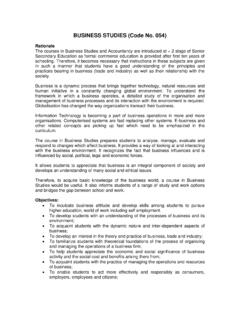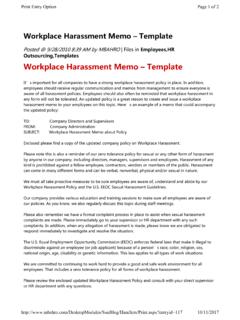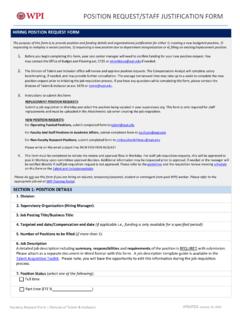Transcription of 2021 Global Shared Services and Outsourcing Survey Report
1 2021 Global Shared Services and Outsourcing Survey ReportForeword 3 Key findings 4 Scope and capabilities 7 Talent models 13 Geography 16 Future of GBS 19 Conclusion 24 ContentsForeword060501040203 Service delivery models are always evolving. For the world s largest companies, there s an increasing shift to leverage Global , multifunctional, and virtual or remote models, especially driven by learnings from COVID-19. These organizations are prioritizing areas across work, workforce, and workplace to be successful in furthering the value which Shared Services and Outsourcing models bring: increasing efficiency, reducing costs, and driving greater business value. Apart from expanding the traditional functional scope, they are developing specialized capabilities such as analytics, reporting, digital, and enhancing the customer experience.
2 These Shared and Global business Services (GBS) constructs are creating an environment where new capabilities can be rapidly adopted to position their customers for success. Organizations are changing the way they look at talent, incorporating diversity within their leadership, driving better employee experience and culture, and focusing on work/life balance and flexible practices as key strategies for retaining , what s clear is that Shared Services centers (SSCs) and GBS models are increasingly evolving and adapting effectively to rapidly changing geopolitical conditions ( , COVID-19 and Brexit) as they seek to provide nimble and value-added Services , a better customer experience, and high-impact business Survey witnessed record participation~600 respondents a 58% increase from 2019 Survey had responses from leaders in 45 countries, with SSC locations across ~75 different countriesSurvey included leaders based not only in parent organizations, but also in SSC organizations across Global centerAbout 56% of the respondents represented companies that had at least $5B in revenueConsumer and energy, resources, and industrial products showed leading participation, contributing more than 50% of respondentsEnergy, resources,and industrial products29%15%Industrial products4%Power10%Oil and gasGovernment andpublic services4%Government, incl.
3 Higher education4%Consumer29%15%Retail and consumer productsAutomotive10%Hospitality4%Techno logy,media, and telecom13%Telecom and media9%4%TechnologyLife sciencesand health care13%Health care9%4%Life sciencesFinancial services11%BankingInsuranceReal estate5%3%3%060501040203 Key findings060501040203 Key themes from this year s surveyFunctions and capabilities scopeBenefitsOrganization structure and talentFuture of GBSO rganizations are beginning to realize greater benefits from RPA implementation, with 20% realizing between 20% and 40% savings (up from 9% in 2019) process efficiency and standardization has overtaken cost reduction as a primary objective for investing in GBS, and more organizations have adopted the digital agendaCost reduction and process efficiency and standardization have been the most tangible and attainable benefits achievedFinance, HR, and IT remain as the top three functions performed in Shared Services centers across industries and continue to grow upstream.
4 And they have moved beyond the back office to include more specialized industry areasGBS footprint for procurement and customer service and call centers has increased the most since 2019 GBS organizations are looking at implementing capabilities such as analytics, process excellence, program management, reporting, and RPAB uilding analytics and reporting capabilities in order to position GBS to drive higher value Enhancing the focus on better customer experience with user-centric design and self-service capabilities Furthering savings achieved through RPA and automation by employing more coordinated, less siloed approachesShifting workplace and workforce strategy to more hybrid delivery models with a focus on developing virtual/ remote work strategies and leveraging location agnostic hiring Multifunctional (more than three functions) continues to be the most prevalent SSC model across industries Organizations are increasingly emphasizing development of strong culture, well-being, and flexible work practices in the fight for talent, with financials being table stakes Contingent workforces, part-time employees, and remote work practices remain the top three nontraditional talent modelAutomation1 Single-instance ERP2 Case and service management3 Cloud4 Cost reduction88%Standardization and process efficiency78% business value63%Objectives achieved:Finance1HR2IT3 SSCIT1 Finance2 Payroll3 OutsourcingTop enablers:About the survey060501040203 Key attributes of successful GBS organizationsMore than 50% of organizations are achieving their objectives.
5 These successful GBS organizations are:~65% of successful organizations include outsourcers in their delivery modelImplementing both Shared Services and Outsourcing models>80% have about a third of their leadership team composed of minorities and womenIncorporating diversity into their leadership rolesEmbracing digital transformation as a strategic agendaMultifunctional in scope, with Finance the most commonly implemented in SSCs67%are building continuous improvement and innovation into talent programs 59%are leveraging contingent workersAdopting new approaches to talentFinanceHRITP rocurement94%57%54%52%Implemented RPAHave a single-instance ERPHave cloud/AWS72%55%53%Scope and capabilities0605010402030506 Scope and capabilities060501040203 How many functions are performed and what is the preferred governance model?How many functions are performed in your SSC or GBS?
6 What is the governance model in your SSC or GBS? Multifunctional organization continue to be most prevalent within the Survey , with ~82% of total SSCs supporting three or more functions; this trend remains consistent for all organizations, irrespective of revenue size Organizations that established their SSCs in earlier years (1991 2000) prefer a hybrid governance model, which has remained a preferred model, while other models like multifunctional leader across SSC and landlord-tenant model have also gained traction in organizations that established SSCs in later years (2001 onward) 1 2 functions3 4 functions5 7 functions8 10 functions>10 functions30%17%19%16%18%Stand-aloneLandl ord-tenantMultifunctional leader across SSCH ybrid SSC withfunctional reporting35%26%24%15%Scope and capabilities060501040203 What percentage of the total FTEs (approximately) are located in the local business , at corporate, or in a GBS model?
7 SSCs or Outsourcing is most leveraged by the payroll function, followed by the customer service or contact center function, which was the highest in 2019 Customer service or contact centers and Procurement have each increased about 10% from 2019 Usual suspects of IT, Finance, Tax, and HR continue to grow year over year0%100%50%Sales and marketingLegalSupply chain andmanufacturing supportR&DHuman resourcesProcurementTaxFinanceInformatio n technologyReal estate andfacilities managementCustomer service orcontact centerPayroll60%20212019N/A64%52%58%55%5 5%42%42%52%40%44%80%73%67%65%60%58%52%49 %48%47%44%35%8%12%17%11%19%14%13%21%80%7 3%38%15%47%36%28%35%15%41%44%67%65%21%18 %60%16%26%58%27%21%52%28%23%49%11%41%48% Increase from 2019 Decrease from 2019 New addition from 2019 No change from 2019 Local businessGBS ( Outsourcing and Shared Services )CorporateScope and capabilities060501040203 What functions are performed by both SSCs and Outsourcing providers?
8 Different industries are now delivering specialized focused capabilities. Examples include:Consumer Manufacturing and plant accounting Asset protection and retail loss intelligenceEnergy, resources, and industrials Product engineering Health, security, environment, and qualityFinancial Services Claims Anti-money launderingLife sciences and health care Clinical trials Medical managementTechnology, media, and telecom Manufacturing and plant accounting Operationalized transfer pricing CyberReal estate andfacilities managementSales and marketingSupply chain and manufacturingLegalInternal audit and riskTaxCustomer serviceor contact centerPayrollProcurementInformation technologyHuman resourcesFinancepercent of respondentspercent of respondentsShared Services centerOutsourced90%44%17%54%17%32%22%17% 7%11%4%5%12%5%57%57%53%51%45%36%26%22%18 %15%16%14%1 Organizations responding to this question are primarily Shared service center and capabilities0605010402030%20%40%60%80%10 0%M&A integrationCustomer experience anduser-centric designKnowledge and content managementChange managementProgram management andtransition managementAnalytics (predictive, customer)
9 TrainingProcess excellenceReportingRPA and automationPlanning to implementHave implemented11%13%22%30%29%40%23%47%16%28 %51%56%27%30%58%33%56%22%44%32% RPA and automation, reporting, and process excellence are now part of at least 50% of GBS organizations Reporting, analytics, customer experience, and user-centric design are the top capabilities that GBS organizations are looking to invest inWhat are the capabilities implemented or planned to be implemented in GBS organizations?Scope and capabilities060501040203 More than 50% of GBS organizations have either implemented or are planning to implement customer experience and user-centric design as a capability Of the 31% respondents who indicated lack of self-service as a top challenge, only 29% listed self-service as a solution that they have employed in their organizations Organizations are proactively taking steps to drive a better customer experience through customer surveys, alignment of service levels to goals, and increased visibility from SSC to business A quarter of organizations did not identify any challenges for their end users in interacting with their centersHow are you driving a better customer experience?
10 Which of the following is the most challenging for your end users and customers when interacting with your center?What steps is your organization currently taking to drive a better customer experience?Long queue wait time for supportLimited channels accessIneffectiveautomationLong responsetimesUnable toresolve issuesNone of the aboveLack of self-service capabilities31%25%19%12%6%4%2% process -le vel councils andcustomer focus groupsVisits from leadershipAdditional investment ininfrastructure and toolsJoint management meetingsIncreased visibility fromSSC to businessAligning service levels to goalsVoice of the Customer surveys67%65%58%57%39%36%29%060501040203 0506 Talent modelsTalent models0605010402030506 How do you attract and retain talent in SSCs and GBS, and what nontraditional talent models have you considered?What are the approaches you have used in the past to try and retain your Shared Services employees?
















